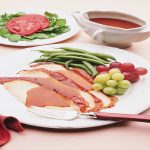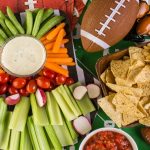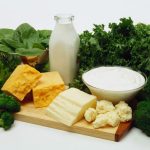
Jynneos is approved for adults considered at high risk for infection read on >

Jynneos is approved for adults considered at high risk for infection read on >
(HealthDay News) — Eating too much meat can make you sick, says New York-Presbyterian Hospital. Too much red meat — especially processed meats like sausages, bacon, salami and hot dogs — contribute to chronic conditions like heart disease, diabetes and obesity. Overeating animal products often means the underconsumption of fiber, which is only found in plant-based foods. Fiber helps the digestive system, help lowers cholesterol and helps you feel full. New York-Presbyterian says most of your calories should come from foods like fruits, vegetables, whole grains, legumes, nuts and seeds.

With pumpkin spice lattes already hitting coffee shops, it’s never too soon to rethink favorite seasonal sips and cut calories without sacrificing flavor. Here are four to try from now until the holidays really begin! Each recipe makes two drinks. Pear Bellini: Pears make the perfect puree to add to champagne, Prosecco or sparking rose. Peel and core a ripe pear. Cut it into slices, reserving two for the garnish. Place the remaining pear slices in a blender along with one ounce of a pear liqueur and two tablespoons of cold water. Blend until smooth and divide between two champagne glasses. Top off each glass with the bubbly of your choice and place a pear wedge on each rim. Peppermint Hot Chocolate: In a small saucepan, whisk two cups skim milk, two tablespoons unsweetened cocoa powder, two tablespoons sugar or the equivalent amount of substitute and a few drops of mint extract (it’s very strong, so taste as you go to keep it from overpowering the cocoa). Heat slowly until warm, about three minutes. Pour into two mugs. Mulled Wine: Heat one cup good quality red wine, a half teaspoon of ground cinnamon, 12 cloves and two quarters of an orange over medium heat for about two minutes until quite warm. Strain into heatproof glass mugs. Real Pumpkin Latte: In a saucepan, whisk together four… read on >

A new study warns that even your soothing cup of tea might serve up some invisible health hazards. Some tea companies are replacing traditional paper teabags with plastic ones, but the new bags may be adding billions of tiny bits of plastic to your beverage, a team from Canada reports. “We show that steeping a single plastic teabag at brewing temperature [205 degrees Fahrenheit] releases approximately 11.6 billion microplastics and 3.1 billion nanoplastics into a single cup of the beverage,” concluded a team led by Nathalie Tufenkji. She’s a professor of chemical engineering at McGill University in Montreal. The global proliferation of microplastics — bits of plastic so small they are often invisible to the naked eye — have made headlines recently, having been found in large numbers in ocean and tap water, seafood and even human poop. “In the past few years, there has been a steadily increasing body of scientific literature demonstrating that not only are microplastics permeating the broader environment, they are entering our bodies, as well,” noted Dr. Kenneth Spaeth, chief of occupational and environmental medicine at Northwell Health in Great Neck, N.Y. He wasn’t involved in the new research. Spaeth stressed that there’s just too little data on whether or not microplastics pose a threat to human health. However, “based on the molecular composition of microplastics, there is reason to… read on >

When you get the urge for a snack, you might not think that a slice of turkey can have the same lip-smacking effect as a handful of chips. But scientists have known for some time that protein is the most efficient nutrient for not only quickly satisfying hunger, but also for keeping you feeling satisfied longer than other foods. Part of the explanation is the longer time it takes to digest protein and its ability to keep your blood sugar level steady. This, in turn, prevents the kind of cravings that seem to kick in soon after you finish, say, a jelly doughnut. Recent research done at the University of Warwick in the United Kingdom has found that there’s even more to this than we thought. Apart from your digestive system, the brain is also a key player in why protein is so satisfying. Receptors in the area of your brain that controls weight quickly respond to the amino acids in certain high-protein foods and send out the message that your hunger has been satisfied. It’s all part of a chain reaction that starts when certain taste buds are activated by protein’s savory flavor, often referred to as umami — the so-called fifth taste after salty, sour, sweet and bitter. Two amino acids in particular elicit the fast response — arginine, which is not one… read on >

This year, when the gang comes over to watch football, score big with these healthy treats. Rich and creamy onion dip with chips is a favorite and so easy to make by mixing sour cream into a flavor packet. But most dip mixes are loaded with MSG, sodium and artificial flavors, plus they have zero nutrition. Instead, make your own in a snap. You’ll keep in the creaminess and keep out the preservatives in that packet. It starts with dehydrated onions that you can find in the spice section of your local grocery store. To make it nutritious, choose plain, protein-rich Greek yogurt. Its tangy taste and creamy thickness is ideal for mimicking sour cream. Then go the extra yard and replace chips with carrots and zucchini spears for dipping. Fast and Easy Onion Dip 3 tablespoons dehydrated onions 2 teaspoons each onion and garlic powder 1 tablespoon each Worcestershire sauce and balsamic vinegar 1 cup plain Greek yogurt Place the dehydrated onions, and onion and garlic powders in a medium bowl and stir. Whisk in the Worcestershire sauce and vinegar. Fold in the yogurt with a spatula and chill for 30 minutes before serving. Yield: 1 generous cup Heart-healthy nuts and seeds make a tasty and filling snack. Choose this spicy blend instead of salted varieties. Sriracha-Spiced Snack Mix 1 teaspoon brown sugar 1/2… read on >

It’s hard to beat the comfort quotient of a hot, bubbling dish of macaroni and cheese, but the fat and calorie overload can be a health disaster. Here’s how to make a lighter version with all the taste intact. Start by choosing a whole grain pasta such as spelt or a gluten-free quinoa pasta. These typically have double the fiber of processed white pasta, plus iron and important B vitamins. Besides cashing in on more nutrients, quinoa pasta is lighter in color than whole-wheat varieties, so the finicky eaters in your house won’t even notice the swap. This recipe gets a flavor boost from extra garlic and uses squash to replace part of the cheese. Squash boosts the vitamin A content of the dish and makes it thick and creamy without having to use a white flour-based roux. You can roast it fresh or buy it precooked and frozen. Lighter Mac ‘N’ Cheese 1 pound macaroni-shaped whole-grain or quinoa pasta 2 teaspoons olive oil 2 cloves garlic, minced 1/2 teaspoon garlic salt 1/4 teaspoon turmeric 1/8 teaspoon black pepper 1 cup skim milk 1/2 cup pureed squash (made with any hard squash such as acorn or butternut) 1-1/2 cups cheddar cheese, shredded Fill a large stockpot with water and bring to a boil. Cook the pasta according to the package instructions. Drain and set aside.… read on >

High blood pressure, or hypertension, is a risk factor for stroke, heart disease and other dangerous conditions, but it offers no early warning signs. That’s why it’s so important to have your pressure checked regularly. You can take preventive steps to keep it in line by getting regular exercise and by adding foods that support a healthy blood pressure to your diet. If you’ve already been diagnosed with high blood pressure, follow your doctor’s orders on medication, but know that a better diet is essential to help those medications work — it might even reduce the number of drugs you need. Healthy diets, like DASH (Dietary Approaches to Stop Hypertension), focus on lowering salt and boosting the minerals calcium and potassium through food. Vegetarians and vegans, in particular, tend to have significantly lower blood pressure and lower odds of hypertension than non-vegetarians, in part from all the extra vegetables and fruits (and their fiber) they eat. These are healthful foods everyone can enjoy more of. What other foods can help? Make sure you’re getting between 1,000 and 1,300 milligrams (mg) of calcium every day from foods like milk and yogurt. A report in the Cochrane Database of Systematic Reviews found that 1,500 mg was even more effective. The omega-3 fatty acids in flax seeds seem to be particularly good for blood pressure. Buy whole brown… read on >

There’s no shortage of reasons to get your omega-3s, which are abundant in fish and their oils. But high consumption of fish and their oils has created a shortage around the world. In addition, fish can be costly, and there are also concerns about toxins, like mercury, which affect many fatty fish to some degree. Since omega-3 fatty acids play a role in vision, brain health, reproduction, and healthy skin and hair, the hunt is on for other sources. One source that’s also a boon for vegans are omega-3s made from marine algae, rich in anti-inflammatory and antioxidant compounds, carotenoids, vitamins and essential amino acids. In fact, eating this algae is how fish become so rich in omega-3s. Harvesting microalgae is not only a more sustainable alternative to fishing, but also algae don’t seem to carry the risk of contamination by pollutants. Scientists are just beginning to explore the health benefits of microalgae and how best to harvest it. But small studies have already found that algae oil capsules can be as effective as eating salmon or taking traditional fish oil supplements. While microalgae is already available in capsule and drop forms, it’s possible that we’ll see it in food and beverages in the not-too-distant future. Also, remember that some plant-based foods deliver omega-3 fatty acids — canola oil, walnuts, ground flaxseed and edamame, to… read on >

Butternut squash, Brussels sprouts and apples are all amazing fall superfoods and the perfect reason to get cooking. Cheap and versatile, butternut squash is loaded with fiber and vitamin A. For an easy butternut squash mash, cut the squash in half, discard the seeds and roast for about 1 hour at 350 degrees. Scoop out the flesh and mash with olive oil, chopped fresh rosemary, grated Pecorino cheese and salt. Roasting is also a great way to prepare Brussels sprouts, rich in vitamins C and K. Cut Brussels sprouts in half and saute with some olive oil in a large skillet over high heat until lightly browned. Then bake in a preheated 400 degree oven for eight to 10 minutes. Sprinkle with balsamic vinegar and chopped hazelnuts. Apples are a great source of hunger-busting fiber, and apples baked in a slow-cooker make for a fabulous, filling dessert that’s quick to prepare. Easy-As-Pie Baked Apples 1/4 cup brown sugar 1/4 cup chopped walnuts, pecans, raisins or prunes 2 tablespoons butter 1 teaspoon cinnamon 6 Gala or Macintosh apples 1/2 cup apple juice or cider 2 tablespoons orange liquor (optional) In a large bowl, mix the sugar, walnuts, butter and cinnamon to make a filling. Using a grapefruit spoon with sharp edges, a melon baller or a small paring knife, core most of the way through each… read on >